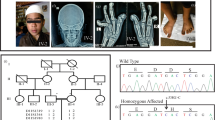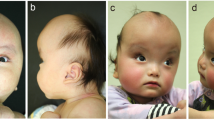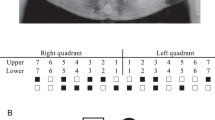Abstract
Chiari malformation type I (CMI) is a congenital abnormality of the cranio-cerebral junction with an estimated incidence of 1 in 1280. CMI is characterized by underdevelopment of the occipital bone and posterior fossa (PF) and consequent cerebellar tonsil herniation. The presence for a genetic basis to CMI is supported by many lines of evidence. The cellular and molecular mechanisms leading to CM1 are poorly understood. The occipital bone formation is dependent on complex interactions between genes and molecules with pathologies resulting from disruption of this delicate process. Whole-exome sequencing of affected and not affected individuals from two Italian families with non-isolated CMI was undertaken. Single-nucleotide and short insertion–deletion variants were prioritized using KGGSeq knowledge-based platform. We identified three heterozygous missense variants: DKK1 c.121G>A (p.(A41T)) in the first family, and the LRP4 c.2552C>G (p.(T851R)) and BMP1 c.941G>A (p.(R314H)) in the second family. The variants were located at highly conserved residues, segregated with the disease, but they were not observed in 100 unaffected in-house controls. DKK1 encodes for a potent soluble WNT inhibitor that binds to LRP5 and LRP6, and is itself regulated by bone morphogenetic proteins (BMPs). DKK1 is required for embryonic head development and patterning. LRP4 is a novel osteoblast expressed receptor for DKK1 and a WNT and BMP 4 pathways integrator. Screening of DKK1 in a cohort of 65 CMI sporadic patients identified another missense variant, the c.359G>T (p.(R120L)), in two unrelated patients. These findings implicated the WNT signaling in the correct development of the cranial mesenchyme originating the PF.
Similar content being viewed by others
Log in or create a free account to read this content
Gain free access to this article, as well as selected content from this journal and more on nature.com
or
References
Barkovich AJ, Wippold FJ, Sherman JL, Citrin CM : Significance of cerebellar tonsillar position on MR. Am J Neuroradiol 1986; 7: 795–799.
Meadows J, Kraut M, Guarnieri M, Haroun RI, Carson BS : Asymptomatic Chiari type I malformations identified on magnetic resonance imaging. J Neurosurg 2000; 92: 920–926.
Milhorat TH, Chou MW, Trinidad EM et al: Chiari I malformation redefined: clinical and radiographic findings for 364 symptomatic patients. Neurosurgery 1999; 44: 1005–1017.
Nishikawa M, Sakamoto H, Hakuba A, Nakanishi N, Inoue Y : Pathogenesis of Chiari malformation: a morphometric study of the posterior cranial fossa. J Neurosurg 1997; 86: 40–47.
Marin-Padilla M, Marin-Padilla TM : Morphogenesis of experimentally induced Arnold–Chiari malformation. J Neurol Sci 1981; 50: 29–55.
Stovner LJ : Headache and Chiari type I malformation: occurrence in female monozygotic twins and first-degree relatives. Cephalalgia 1992; 12: 304–307.
Herman MD, Cheek WR, Storrs BB : Two siblings with the Chiari 1 malformation. Pediatr Neurosurg 1990; 16: 183–184.
Speer MC, Enterline DS, Mehltretter L et al: Chiari type I malformation with or without syringomyelia: prevalence and genetics. J Genet Couns 2003; 12: 297–311.
Speer MC, George TM, Enterline DS, Franklin A, Wolpert CM, Milhorat TH : A genetic hypothesis for chiari i malformation with or without syringomyelia. Neurosurg Focus 2000; 8: E12.
Saldino RM, Steinbach HL, Epstein CJ : Familial acrocephalosyndactyly (Pfeiffer syndrome). Am J Roentgenol Radium Ther Nucl Med 1972; 116: 609–622.
Strahle J, Muraszko KM, Buchman SR, Kapurch J, Garton HJL, Maher CO : Chiari malformation associated with craniosynostosis. Neurosurg Focus 2011; 31: E2.
Cinalli G, Renier D, Sebag G, Sainte-Rose C, Arnaud E, Pierre-Kahn A : Chronic tonsillar herniation in Crouzon’s and Apert’s syndromes: the role of premature synostosis of the lambdoid suture. J Neurosurg 1995; 83: 575–582.
Leikola J, Koljonen V, Valanne L, Hukki J : The incidence of Chiari malformation in nonsyndromic, single suture craniosynostosis. Childs Nerv Syst 2010; 26: 771–774.
Pouratian N, Sansur CA, Newman SA, Jane Jr JA, Jane JA : Sr: Chiari malformations in patients with uncorrected sagittal synostosis. Surg Neurol 2007; 67: 422–427.
McBratney-Owen B, Iseki S, Bamforth SD, Olsen BR, Morriss-Kay GM : Development and tissue origins of the mammalian cranial base. Dev Biol 2008; 322: 121–132.
Li H, Durbin R : Fast and accurate short read alignment with Burrows-Wheeler transform. Bioinformatics 2009; 25: 1754–1760.
McKenna A, Hanna M, Banks E et al: The genome analysis toolkit: a MapReduce framework for analyzing next-generation DNA sequencing data. Genome Res 2010; 20: 1297–1303.
Li MX, Gui HS, Kwan JS, Bao SY, Sham PC : A comprehensive framework for prioritizing variants in exome sequencing studies of Mendelian diseases. Nucleic Acids Res 2012; 40: e53.
Wilkie AOM, Morriss-Kay GM : Genetics of craniofacial development and malformation. Nat Rev Genet 2001; 2: 458–468.
Glinka A, Wu W, Delius H, Monaghan AP, Blumenstock C, Niehrs C : Dickkopf-1 is a member of a new family of secreted proteins and functions in head induction. Nature 1998; 391: 357–362.
Pinzone JJ, Hall BM, Thudi NK et al: The role of Dickkopf-1 in bone development, homeostasis, and disease. Blood 2009; 113: 517–525.
Bourhis E, Wang W, Tam C et al: Wnt antagonists bind through a short peptide to the first b-propeller domain of LRP5/6. Structure 2011; 19: 1433–1442.
Li Y, Lu W, King TD et al: Dkk1 stabilizes Wnt co-receptor LRP6: implication for Wnt ligand-induced LRP6 downregulation. PLoS One 2010; 5: e11014.
Mukhopadhyay M, Shtrom S, Rodriguez-Esteban C et al: Dickkopf1 is required for embryonic head induction and limb morphogenesis in the mouse. Dev Cell 2001; 1: 423–434.
Semënov M, Tamai K, He X : SOST is a ligand for LRP5/LRP6 and a Wnt signaling inhibitor. J Bio Chem 2005; 280: 26770–26775.
Itasaki N, Jones CM, Mercurio S et al: Wise, a context-dependent activator and inhibitor of Wnt signaling. Development 2003; 130: 4295–4305.
Choi HY, Dieckmann M, Herz J, Niemeier A : Lrp4, a novel receptor for Dickkopf 1 and sclerostin, is expressed by osteoblasts and regulates bone growth and turnover in vivo. PLoS One 2009; 4: e793.
Bao J, Zheng JJ, Wu D : The structural basis of DKK-mediated inhibition of Wnt/LRP signaling. Sci Signal 2012; 5: pe22.
Johnson EB, Hammer RE, Herz J : Abnormal development of the apical ectodermal ridge and polysyndactyly in Megf7-deficient mice. Hum Mol Genet 2005; 14: 3523–3538.
Wang RN, Green J, Wang Z et al: Bone morphogenetic protein (BMP) signaling in development and human diseases. Genes Dis 2014; 1: 87–105.
Garrigue-Antar L, Barker C, Kadler KE : Identification of amino acid residues in bone morphogenetic protein-1 important for procollagen C-proteinase activity. J Biol Chem 2001; 276: 26237–26242.
Kronenberg D, Vadon-Le Goff S, Bourhis JM et al: Strong cooperativity and loose geometry between CUB domains are the basis for procollagen c-proteinase enhancer activity. J Biol Chem 2009; 284: 33437–33446.
Suzuki N, Labosky PA, Furuta Y et al: Failure of ventral body wall closure in mouse embryos lacking a procollagen C-proteinase encoded by Bmp1, a mammalian gene related to Drosophila tolloid. Development 1996; 122: 3587–3595.
Cho SY, Asharani PV, Kim OH et al: Identification and in vivo functional characterization of novel compound eterozygous BMP1variants in osteogenesis imperfecta. Hum Mutat 2015; 36: 191–195.
Korvala J, Löija M, Mäkitie O et al: Rare variations in WNT3A and DKK1 may predispose carriers to primary osteoporosis. Eur J Med Genet 2012; 55: 515–519.
Markunas CA, Enterline DS, Dunlap K et al: Genetic evaluation and application of posterior cranial fossa traits as endophenotypes for Chiari type I malformation. Ann Hum Genet 2014; 78: 1–12.
Mishina Y, Snider TN : Neural crest cell signaling pathways critical to cranial bone development and pathology. Exp Cell Res 2014; 325: 138–147.
Mani P, Jarrell A, Myers J, Atit R : Visualizing canonical Wnt signaling during mouse craniofacial development. Dev Dyn 2010; 239: 354–363.
Lintern KB, Guidato S, Rowe A, Saldanha JW, Itasaki N : Characterization of wise protein and its molecular mechanism to interact with both Wnt and BMP signals. J Biol Chem 2009; 284: 23159–23168.
Shen C, Xiong W-C, Me L : LRP4 in neuromuscular junction and bone development and diseases. Bone 2015; 80: 101–108.
Ohkawara B, Cabrera-Serrano M, Nakata T et al: LRP4 third b-propeller domain mutations cause novel congenital myasthenia by compromising agrin-mediated MuSK signaling in a position-specific manner. Hum Mol Genet 2014; 2: 1856–1868.
Sgouros S, Hockley AD, Goldin JH, Wake MJ, Natarajan K : Intracranial volume change in craniosynostosis. J Neurosurg 1999; 91: 617–625.
Behr B, Longaker MT, Quarto N : Differential activation of canonical Wnt signaling determines cranial sutures fate: a novel mechanism for sagittal suture craniosynostosis. Dev Biol 2010; 344: 922–940.
Gregory CA, Singh H, Perry AS, Prockop DJ : The Wnt signaling inhibitor Dkk-1 is required for re-entry into the cell cycle of human adult stem cells from bone marrow (hMSCs). J Biol Chem 2003; 278: 28067–28078.
Bengtsson T, Aszodi A, Nicolae C et al: Loss of alpha10beta1 integrin expression leads to moderate dysfunction of growth plate chondrocytes. J Cell Sci 2005; 118: 929–936.
Yang X, Trehan SK, Guan Y et al: Matrilin-3 inhibits chondrocyte hypertrophy as a bone morphogenetic protein-2 antagonist. J Biol Chem 2014; 289: 34768–34779.
Stickens D, Zak BM, Rougier N, Esko JD : Mice deficient in Ext2 lack heparan sulfate and develop exostoses. Development, 2005; 132: 5055–5068.
Acknowledgements
We thank the families who agreed to participate to the research study. PDM is funded by Fondazione Gerolamo Gaslini and Trust Aletti. EM was funded by Trust Aletti. AIMA CHILD (Associazione Italiana Malformazione di Chiari Child) funded the project.
Author information
Authors and Affiliations
Corresponding author
Ethics declarations
Competing interests
The authors declare no conflict of interest.
Additional information
Supplementary Information accompanies this paper on European Journal of Human Genetics website
Supplementary information
Rights and permissions
About this article
Cite this article
Merello, E., Tattini, L., Magi, A. et al. Exome sequencing of two Italian pedigrees with non-isolated Chiari malformation type I reveals candidate genes for cranio-facial development. Eur J Hum Genet 25, 952–959 (2017). https://doi.org/10.1038/ejhg.2017.71
Received:
Revised:
Accepted:
Published:
Issue date:
DOI: https://doi.org/10.1038/ejhg.2017.71
This article is cited by
-
Chiari I malformation: management evolution and technical innovation
Child's Nervous System (2023)
-
Chiari 1 malformation and exome sequencing in 51 trios: the emerging role of rare missense variants in chromatin-remodeling genes
Human Genetics (2021)
-
Small posterior fossa in Chiari I malformation affected families is significantly linked to 1q43-44 and 12q23-24.11 using whole exome sequencing
European Journal of Human Genetics (2019)
-
Chiari malformation type I: what information from the genetics?
Child's Nervous System (2019)



